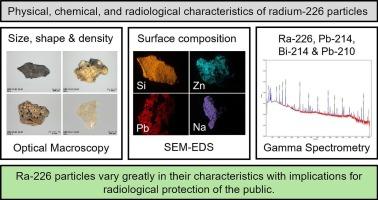遗留污染中Ra-226粒子的特征及其对放射防护的影响。
IF 8
1区 环境科学与生态学
Q1 ENVIRONMENTAL SCIENCES
引用次数: 0
摘要
放射性粒子是物理上离散的放射性源,由于过去的事故、事件和实践而释放到环境中,可能对公众构成危害。镭在飞机部件照明中的历史使用,以及随后这些飞机的退役和相关的废物处理做法,留下了污染的遗留问题,例如苏格兰达尔盖蒂湾含有Ra-226的放射性颗粒。这项研究的目的是在物理、化学和放射学上对来自达尔盖提湾的Ra-226粒子进行表征,并考虑其对公众辐射防护的影响。物理特性测量颗粒的大小和形状使用光学宏观与图像分析,测量颗粒质量,计算颗粒密度,以及对其物理外观的一般观察。化学表征用扫描电子显微镜和能量色散x射线能谱法测量表面元素组成,用伽马能谱法测量Ra-226及其γ发射子放射性核素的活度。在视觉外观上的定性观察表明,有5个不同的亚种群,大小、形状和密度的测量差异很大。观察到各种各样的表面化学成分,并以沙粒和盐沉积的形式可见其河口起源的证据。在所有样品中均检测到Ra-226、Pb-214、Bi-214和Pb-210,活性超过几个数量级,且长期平衡程度不同。调查中还包括两个原始飞机人工制品,与之比较,颗粒和人工制品的特征不同,表明源材料发生了改变。粒子特性的多样性影响了公众对Ra-226粒子的辐射防护,包括暴露途径、辐射剂量评估和在环境中的寿命。本文章由计算机程序翻译,如有差异,请以英文原文为准。

Characteristics of Ra-226 particles from legacy contamination and implications for radiological protection
Radioactive particles are physically discrete sources of radioactivity that have been released into the environment as result of past accidents, incidents, and practices, and can present a hazard to members of the public. The historical use of radium in the luminising of aircraft components, and the subsequent decommissioning of those aircraft and associated waste disposal practices, has left a legacy of contamination, such as the radioactive particles containing Ra-226 at Dalgety Bay, Scotland. The aim of this research was to physically, chemically, and radiologically characterise Ra-226 particles from Dalgety Bay and consider the implications for radiological protection of the public. Physical characterisation measured particle size and shape using optical macroscopy with image analysis, measured particle mass, and calculated particle density, as well as general observations on their physical appearance. Chemical characterisation used scanning electron microscopy with energy dispersive X-ray spectroscopy to measure surface elemental composition, and gamma spectrometry was used to measure the activities of Ra-226 and its gamma-emitting daughter radionuclides. Qualitative observations on visual appearance indicated there were five distinct subpopulations, and measurements of size, shape and density varied widely. A wide range of surface chemical compositions were observed, and evidence of their estuarine origin was visible in the form of sand grains and salt deposits. Ra-226, Pb-214, Bi-214 and Pb-210 were detected in all samples with activities over several orders of magnitude and varying degrees of secular equilibrium. Two original aircraft artefacts were also included in the investigation, comparison with which showed the particles and artefacts differed in their characteristics, indicating that the source material has undergone alteration. The diversity of particle characteristics has implications for the radiological protection of the public from Ra-226 particles including pathways of exposure, assessment of radiation dose, and longevity in the environment.
求助全文
通过发布文献求助,成功后即可免费获取论文全文。
去求助
来源期刊

Science of the Total Environment
环境科学-环境科学
CiteScore
17.60
自引率
10.20%
发文量
8726
审稿时长
2.4 months
期刊介绍:
The Science of the Total Environment is an international journal dedicated to scientific research on the environment and its interaction with humanity. It covers a wide range of disciplines and seeks to publish innovative, hypothesis-driven, and impactful research that explores the entire environment, including the atmosphere, lithosphere, hydrosphere, biosphere, and anthroposphere.
The journal's updated Aims & Scope emphasizes the importance of interdisciplinary environmental research with broad impact. Priority is given to studies that advance fundamental understanding and explore the interconnectedness of multiple environmental spheres. Field studies are preferred, while laboratory experiments must demonstrate significant methodological advancements or mechanistic insights with direct relevance to the environment.
 求助内容:
求助内容: 应助结果提醒方式:
应助结果提醒方式:


